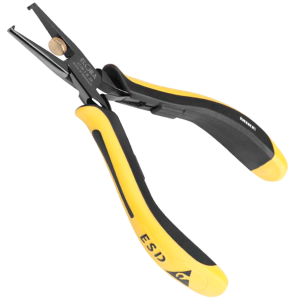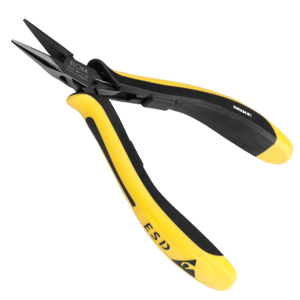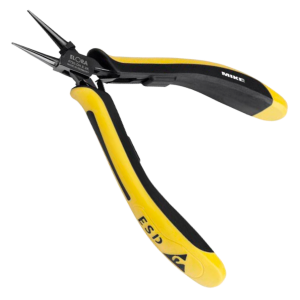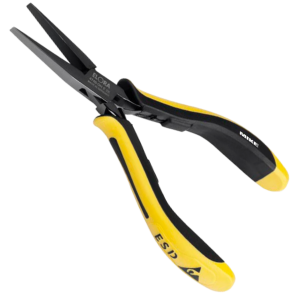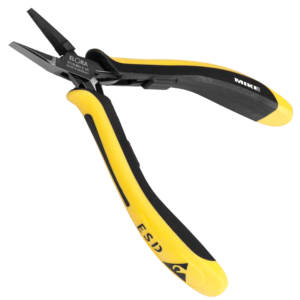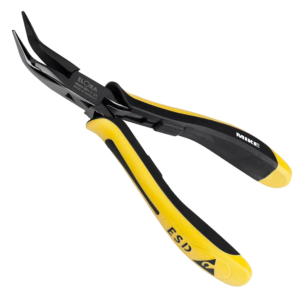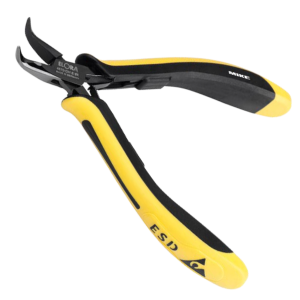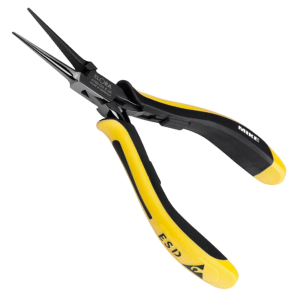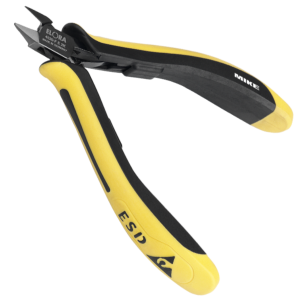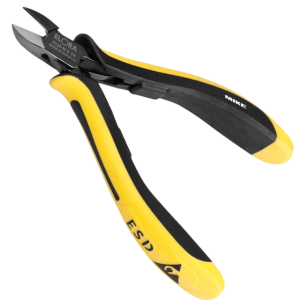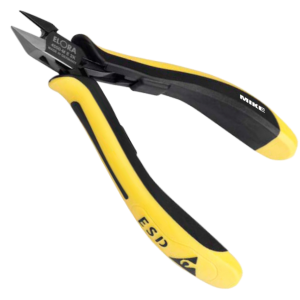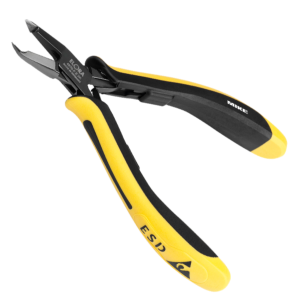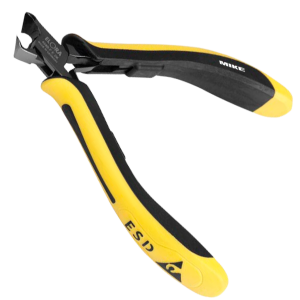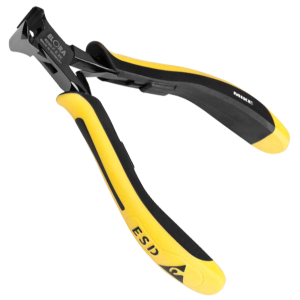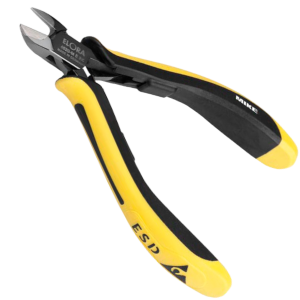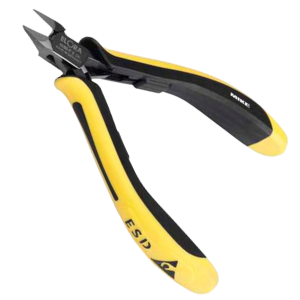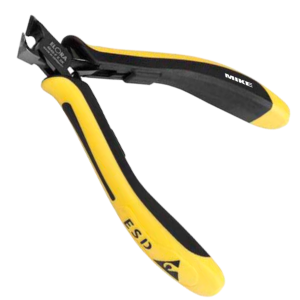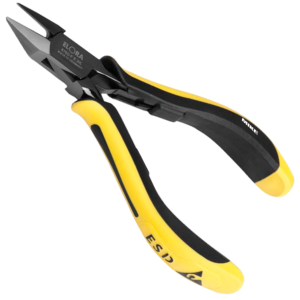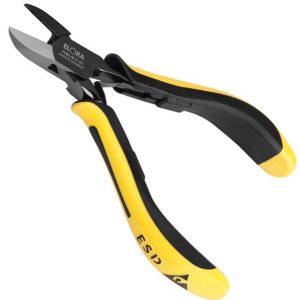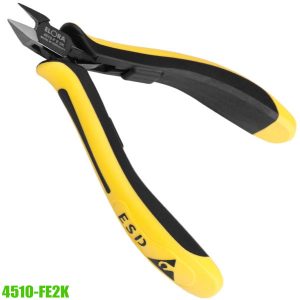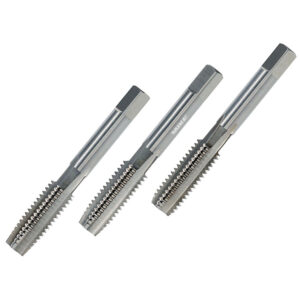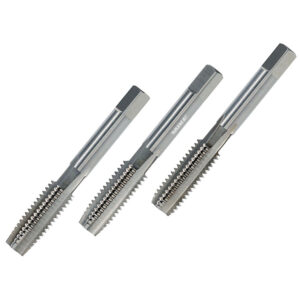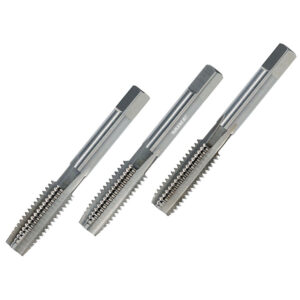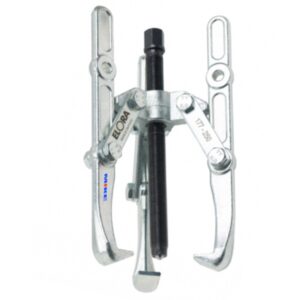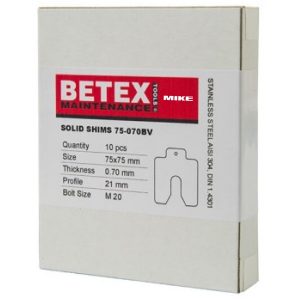ESD, or Electro Static Discharge, is a quick and intense release of electricity caused by significant voltage differences in insulating materials, often unnoticed by humans. This static electricity can permanently damage electronic components. To combat this risk, a series of protective measures are employed, such as creating Electrostatic Protected Areas (EPAs) designed to safely neutralize electrostatic charges.
Essential to such workplaces are dissipative clothing, ESD armbands, and specifically designed tools to prevent electrostatic damage. ELORA’s ESD tools adhere to the DIN IEC 61340-5-1 standard, featuring conductive handles with a resistance between 10^6 to 10^9 Ohms to ensure a gentle discharge process, keeping sensitive parts safe even during direct contact.
ELORA offers a wide range of pliers tailored for professional use, from design to material choice. The pliers are forged with precision for unmatched quality and equipped with ergonomic, anti-static handles for secure use and effective force transmission. Specialized versions include models with carbon steel C45 or high-alloy steels for optimal hardness and durability, catering to various needs from gripping to cutting.
Some cutters are even fitted with carbide edges for dealing with particularly tough materials like piano wire, enhancing their use in the electronics and aviation sectors. Each piece is finely crafted, from hand grinding to surface finishing, ensuring each tool is not only functional but visually impressive.
ESD tools for electronics and precision engineering, the significance of tools that safeguard against electrostatic discharge (ESD) cannot be overstated. ESD can inadvertently damage sensitive electronic components, leading to malfunction or failure. This makes ESD-safe tools indispensable for professionals who work with such components. Among these tools, the side cutter series from ELORA, a name synonymous with quality and reliability in the tool industry, stands out for its comprehensive range designed to meet various needs.
The ELORA ESD side cutter series, made from high-grade tool steel (C45 / 1.0503 or Chrome-Vanadium 80 CrV2 / 1.2235), offers exceptional durability and precision. These tools are coated with a polished, high gloss gunmetal finish, not just for aesthetics but also for added protection against corrosion. They are equipped with 2-C ESD handles that provide a surface resistance of 10^6 to 10^9 Ohm, ensuring safe use in environments where electrostatic discharge poses a risk.
This series includes models with distinct features tailored to specific tasks:
- Electronic Side Cutters are available with various head shapes (e.g., straight, oblique) and jaw types (e.g., fine bevel, without bevel) to accommodate different precision cutting needs. Models like the 4520, 4550, and 4760 are designed for cutting everything from soft wires to very hard materials, including piano wire, with lengths ranging from 120 to 135 mm and weights approximately 91 to 143 grams.
- Electronic Snipe Nose Pliers are crucial for gripping and bending work in tight or hard-to-reach areas. The 4670 and 4680 models, for example, feature long, straight jaws for precise manipulation, available with smooth or serrated gripping surfaces to match the task at hand.
- Electronic Oblique Cutters and Tip Cutters, such as the 4570 and 4690 models, offer solutions for virtually flush cutting of wires at angles or in difficult-to-access locations, enhancing the versatility and precision of the ESD tool lineup.
Each tool in the ELORA ESD side cutter series is manufactured in Germany, adhering to stringent DIN ISO 9655 and ESD: DIN IEC 61340-5-1 standards. This ensures that each cutter not only meets the highest quality and safety requirements but also provides the precision and durability professionals need.
ELORA ESD side cutter series exemplifies the blend of innovation, quality, and safety necessary for today’s electrostatic-sensitive work environments. Whether for cutting, gripping, or bending, these tools offer unparalleled precision and protection, making them a valuable addition to any professional’s toolkit.
ESD pliers
Showing all 22 results

